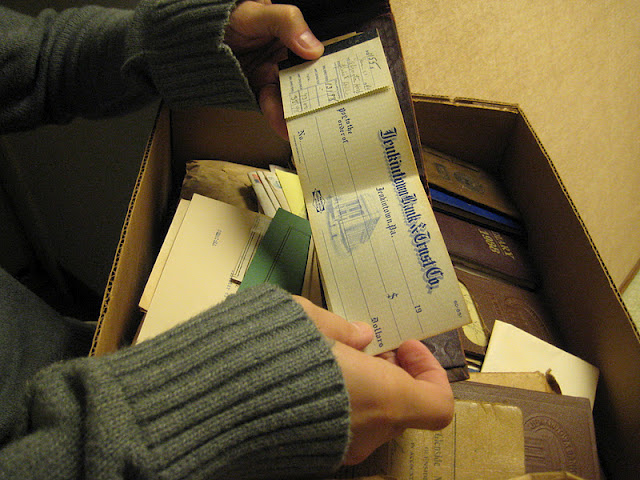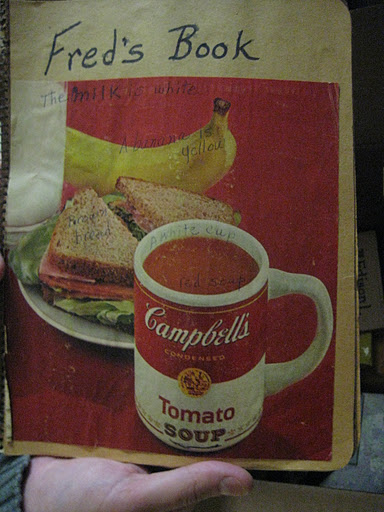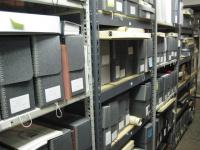It didn't take us long, working on the "Small Repository Project," to realize that there are small repositories and there are small repositories. The Old York Road Historical Society, comparatively speaking, is not such a small repository. On one hand, they do fit our profile for a small repository: no full-time, professionally-trained archivist on-staff; annual operating budget under our cut-off; primary purpose dedicated to history. But on the other hand, Old York Road has about 450 linear feet of materials; they produce a scholarly journal, Old York Road Historical Society Bulletin, which has been in publication since 1937; they contract a freelance archivist from time to time to process collections according to best practices and up-to-date standards. This is no ramshackle enterprise.
We started surveying at Old York Road back in October, but paused for a few months while we visited other repositories. Our final visit a few weeks ago was a good occasion to recall some of the issues we struggled with at Old York Road, the first of our big-small repositories.
 The basic problem at Old York Road was how to handle such a large amount of material. If we had surveyed every single collection in their 450-linear-feet holdings, we may still have finished up at Old York Road by now--but we wouldn't have been to most of the other 20 repositories we have visited in the intervening months! For goodness' sake, the Old York Road Historical Society maintains FIVE off-site storage locations in addition to their main stacks.
The basic problem at Old York Road was how to handle such a large amount of material. If we had surveyed every single collection in their 450-linear-feet holdings, we may still have finished up at Old York Road by now--but we wouldn't have been to most of the other 20 repositories we have visited in the intervening months! For goodness' sake, the Old York Road Historical Society maintains FIVE off-site storage locations in addition to their main stacks.
The most important policy decision we made at Old York Road was about "legacy finding aids." For our purposes, a legacy finding aid is any description of an archival collection created by a repository prior to our arrival. This could be a paper document written up on a typewriter in the 1970s, an entry in PastPerfect (museum software), or, as at Old York Road, Microsoft Word documents. Now, typically, we survey archival collections "from scratch": we dig through the materials, gather information to describe the scope and contents of the collection, and then assign assessment ratings in categories including quality of housing, condition of materials, research value, etc. However, we decided at Old York Road that re-surveying collections for which legacy descriptions already existed would entail too much duplication of effort. We save a lot of time by simply converting the format of the old descriptive data into EAD, the professional standard for online descriptions of archival collections. As long as the descriptions are findable online, we have achieved the primary goal of the Hidden Collections Initiative for Pennsylvania Small Archival Repositories--"un-hiding" the collections.
 This approach is not without downsides. In most cases, the descriptions in legacy finding aids are not as detailed as we would write, or don't include all the types of data that we like to include. Sometimes there are intractable formatting issues that cost us more time than we intended to spend. Perhaps most significantly, we lose the opportunity to assign assessment ratings. These ratings are never available to the public, but they are an invaluable tool for repository staff: they indicate important preservation issues and offer advice for best directing limited resources. And, over the course of the project, the aggregated assessment data will give an overview of the general state of collections held at small archival repositories. It is a pity to forfeit the opportunity to collect this data about every collection, and yet we stand behind our pragmatic decision. Usually, the collections that are well-described are also physically processed and well-housed. If someone took the time to examine and describe the collection, they probably noted preservation issues and re-housed materials appropriately as they went. Or so we hope.
This approach is not without downsides. In most cases, the descriptions in legacy finding aids are not as detailed as we would write, or don't include all the types of data that we like to include. Sometimes there are intractable formatting issues that cost us more time than we intended to spend. Perhaps most significantly, we lose the opportunity to assign assessment ratings. These ratings are never available to the public, but they are an invaluable tool for repository staff: they indicate important preservation issues and offer advice for best directing limited resources. And, over the course of the project, the aggregated assessment data will give an overview of the general state of collections held at small archival repositories. It is a pity to forfeit the opportunity to collect this data about every collection, and yet we stand behind our pragmatic decision. Usually, the collections that are well-described are also physically processed and well-housed. If someone took the time to examine and describe the collection, they probably noted preservation issues and re-housed materials appropriately as they went. Or so we hope.
We thank the Old York Road Historical Society not only for sharing their interesting and valuable collections, but also for presenting challenges that have caused us to hone our project goals and set important policies. In the months that come we will continue to wrestle with new decisions and refine our methodology, so stay tuned!
Update, November 2012: As the project progressed, we refined our methodology and workflow and found that our rate of surveying was faster than we originally anticipated. We now think it will be possible to visit and survey nearly every willing, eligible small repository in our five-county area--an estimated 150-200 repositories in all--by the end of HCI-PSAR Phase II (fall 2014). That means the assessments data we have been aggregating on collections conditions may reflect nearly every small repository archival collection in the region! So, in the interest of "good data," we revised our policy decision and decided that we will assess collections with legacy finding aids. We will still re-use the existing collections descriptions, in the interest of expediency and out of respect for the hard workers who wrote the legacy finding aids. However, we will assess the collections according to our regular methodology. At the end of the project, we will be able to make accurate, informed statements about the state of all archival collections in small repositories--not just the unprocessed ones.

